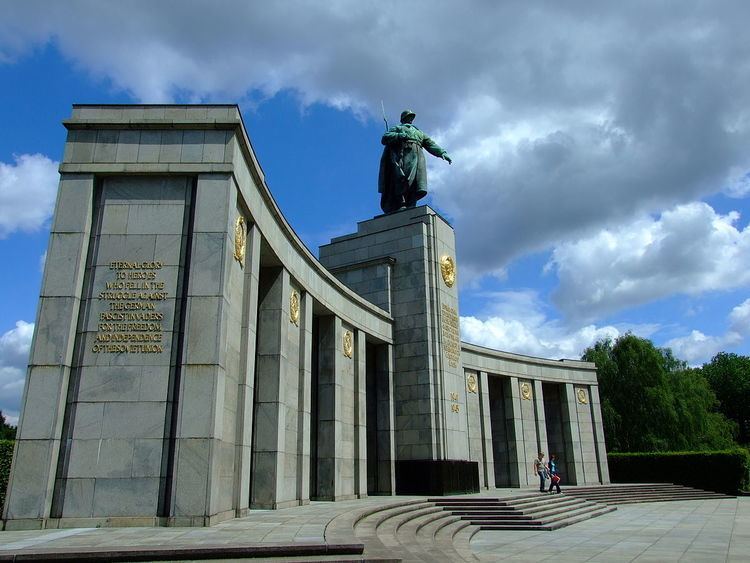Unveiled 1945 Designed by Mikhail Gorvits Opened 1945 | Total commemorated 5,000 | |
 | ||
Hours Open today · Open 24 hoursTuesdayOpen 24 hoursWednesdayOpen 24 hoursThursdayOpen 24 hoursFridayOpen 24 hoursSaturdayOpen 24 hoursSundayOpen 24 hoursMondayOpen 24 hoursSuggest an edit Similar | ||
The Soviet War Memorial (Tiergarten) is one of several war memorials in Berlin, capital city of Germany, erected by the Soviet Union to commemorate its war dead, particularly the 80,000 soldiers of the Soviet Armed Forces who died during the Battle of Berlin in April and May 1945.
Contents
The memorial is located in the Großer Tiergarten, a large public park to the west of the city centre, on the north side of the east-west Straße des 17. Juni (17 June Street) in the Tiergarten locality.
Site
This memorial was erected in 1945, within a few months of the capture of the city. Early photographs show the memorial standing in a wilderness of ruins, the Tiergarten having been destroyed by incendiary bombs and then stripped of timber for firewood during the last months of the war. Today, it is surrounded by the extensive woodlands of the reconstituted Tiergarten. Although the memorial stood in the British sector of Berlin, its construction was supported by all the Allied powers. Throughout the Cold War, Soviet honor guards from the Soviet sector (East Berlin) were sent to stand watch at the memorial.
Design
Built in a style similar to other Soviet World War II monuments once found all over the former Eastern bloc, the memorial takes the form of a curved stoa topped by a large statue of a Soviet soldier. It is set in landscaped gardens and flanked by two Red Army ML-20 152mm gun-howitzer artillery pieces and two T-34 tanks. Behind the memorial is an outdoor museum showing photographs of the memorial's construction and giving a guide to other memorials in the Berlin area. A large Cyrillic inscription is written underneath the soldier statue, which is translated as "Eternal glory to heroes who fell in battle with the German fascist invaders for the freedom and independence of the Soviet Union". The Soviets built the statue with the soldier's arm in a position to symbolize the Red Army's putting down of the Nazi German state.
The memorial was designed by architect Mikhail Gorvits with the monument of the Soviet soldier by sculptors Vladimir Tsigal and Lev Kerbel.
A legend that the memorial was built from stonework taken from the destroyed Reich Chancellery is untrue, but remains popular and persists.
The memorial today
The memorial is still a site of active commemoration. On the anniversary of VE Day, (8 May), wreath-laying ceremonies are held at the memorial. It is a site of pilgrimage for war veterans from the countries of the former Soviet Union. It is also a popular tourist attraction, since it is much closer to the centre of the city than the larger Soviet war memorial at Treptower Park. The memorial is maintained by the City of Berlin.
There is a sign next to the monument explaining in English, German and Russian that this is the burial site of some 2,000 fallen Soviet soldiers. It is located in the heart of Berlin along one of the major roads with a clear sight of the Reichstag and the Brandenburg gate, both symbols of the city. Some of the marble used to build it came from the destroyed government buildings nearby, and it is built on a place which Adolf Hitler meant to devote to Welthauptstadt Germania. Besides the main inscription, the columns state names of only some dead Heroes of the Soviet Union buried here. It has earned some unflattering nicknames, such as the "Tomb of the Unknown Rapist", from the local population with references to crimes committed by Soviet occupation troops.
The monument is built in the British sector of (western) Berlin; after the Berlin wall was erected in 1961, the monument was seen as a sign of communist provocation on West Berlin soil and had to be protected from West Berliners by British soldiers. In 1970 a neo-Nazi, Ekkehard Weil, shot and severely wounded one of the Soviet honour guards at the monument. In 2010, the monument was vandalized just before Victory in Europe Day celebrations with red graffiti that read "thieves, murderers, rapists", sparking a protest from the Russian embassy in Berlin that accused German authorities of not taking sufficient measures to protect the monument. The German tabloid Bild launched a Bundestag-petition to remove the Soviet tanks from the memorial site as a response to the Crimean crisis in 2014, calling them a "martial war symbol". The petition was subsequently denied by the German federal government.
In popular culture
The monument is featured in the 1989 Cold War thriller The Package.
